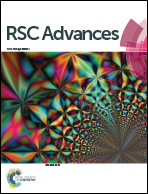Palladium nanoparticles produced and dispersed by Caldicellulosiruptor saccharolyticus enhance the degradation of contaminants in water
Abstract
This study focused on examining the general applicability of coupling bio-palladium (Pd) nanoparticle generation and bio-H2 produced by Caldicellulosiruptor saccharolyticus for wastewater treatment under extreme thermophilic conditions. Na2PdCl4 was added to cell cultures to achieve a final Pd concentration of 50 mg L−1. Methyl orange (MO) and diatrizoate were chosen as the contaminants in water. In the cultures with, and without, Pd added, MO (100 mg L−1) was degraded within 30 min and in over 6 h, respectively. Diatrizoate (20 mg L−1) was degraded within 10 min in Pd-added cultures. However, no diatrizoate degradation happened without Pd addition. The degradation rates were correlated positively with dissolved hydrogen generated by C. saccharolyticus. Furthermore, the catalytic actions of Pd(0) nanoparticles and cells were distinguished during the degradation process. MO was degraded under the combined action of Pd(0) and hydrogenase. However, Pd(0) was the essential catalyst, and hydrogenase had no effect on the deiodination of diatrizoate within 20 min. Pd(0) particles were dispersed well by the cells of C. saccharolyticus and showed a better catalytic activity than Pd(0) formed without cells. Dissolved hydrogen produced by C. saccharolyticus should be the perfect reduction equivalent for Pd formation and for reducing degradation. Therefore, Pd should be added to C. saccharolyticus cultures to enhance the degradation of contaminants in water.


 Please wait while we load your content...
Please wait while we load your content...